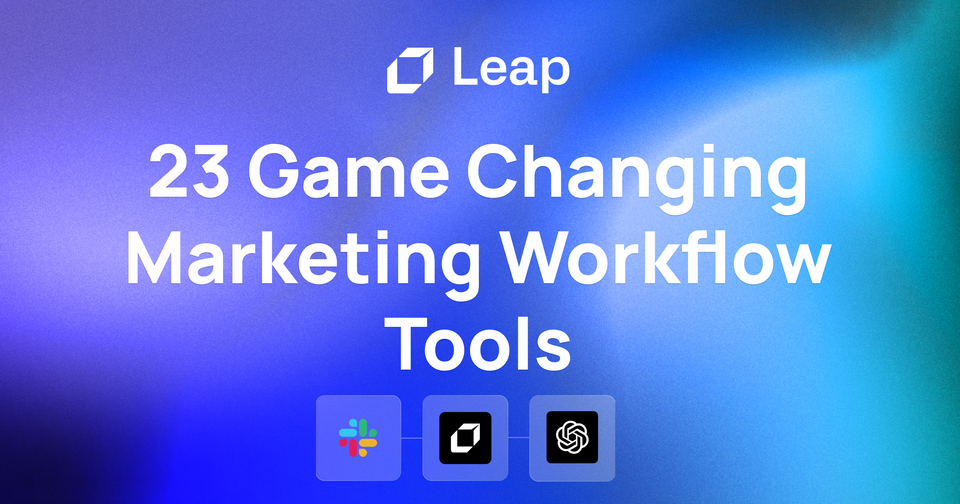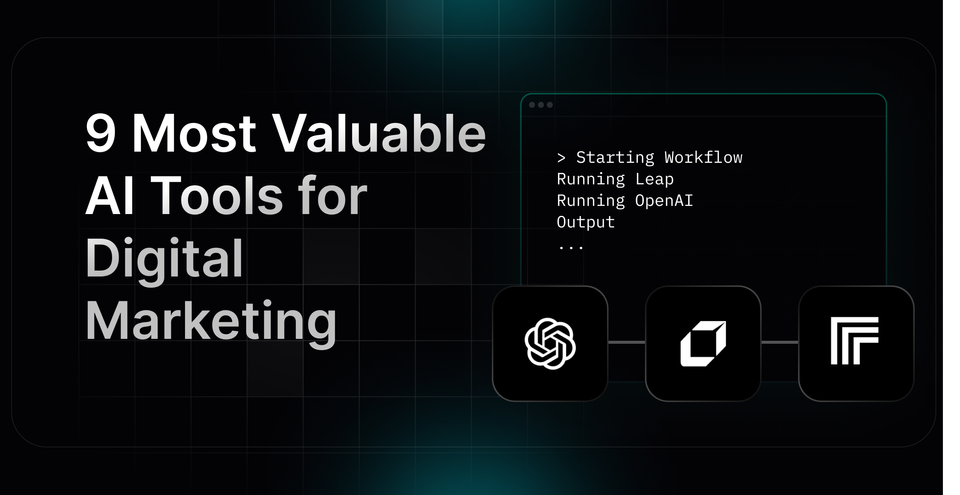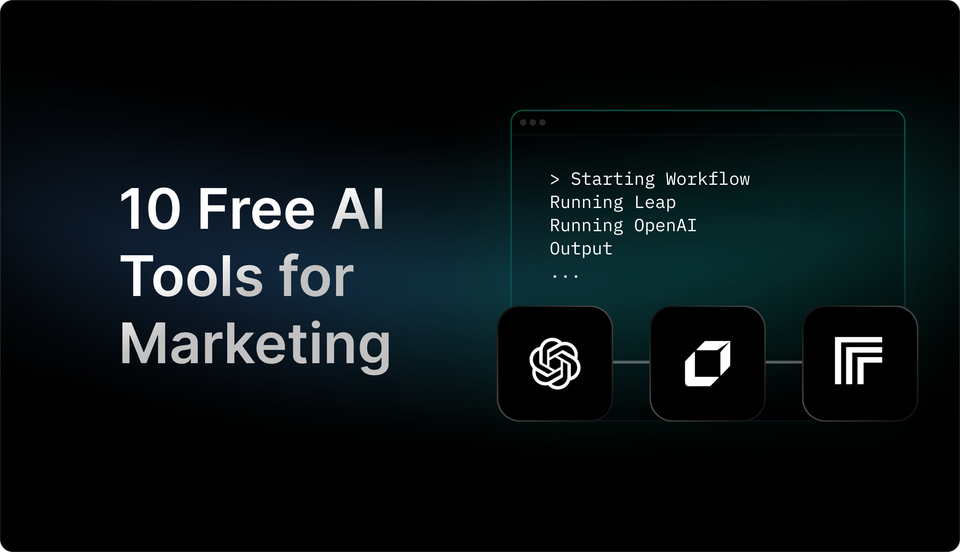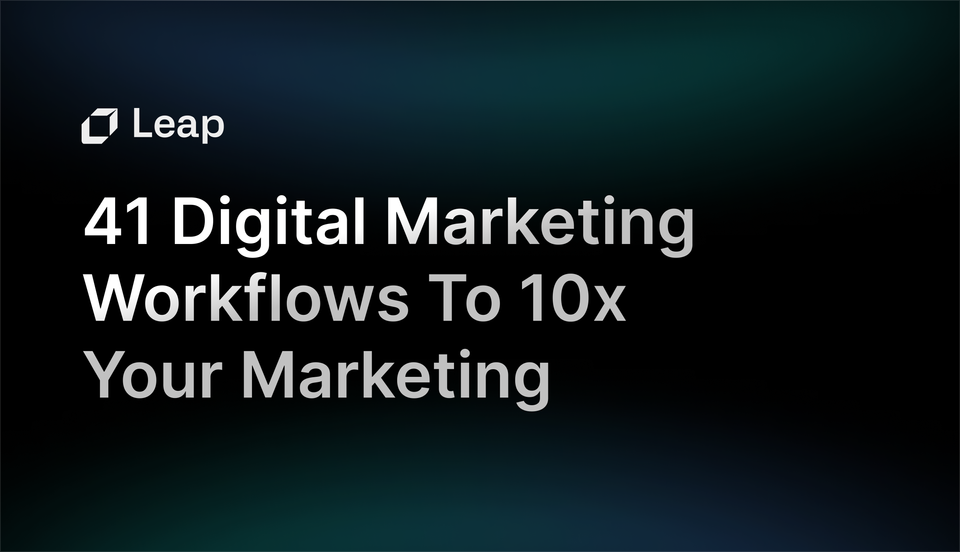34 Best Marketing Workflow Examples for Businesses
Explore effective marketing workflow examples. Streamline strategies, boost efficiency, and elevate your campaigns for optimal success.
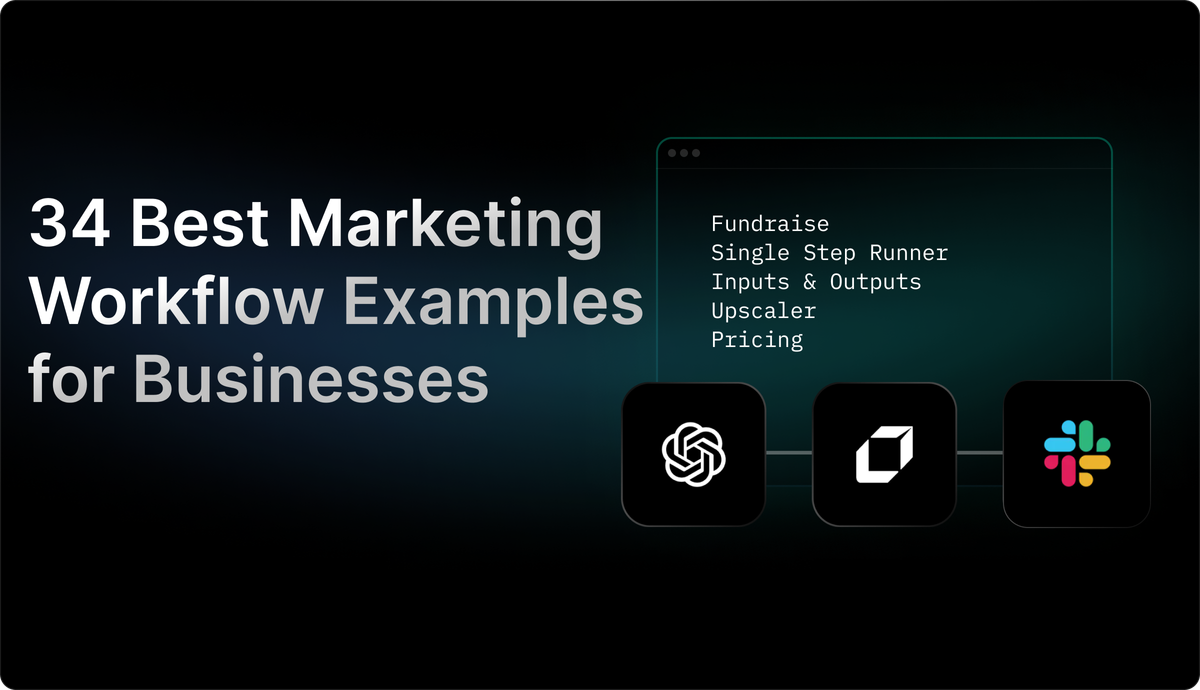
In the fast-paced world of marketing, it's crucial to have a well-organized and efficient workflow in place. But how exactly do you go about creating a marketing workflow that works for your team? Look no further, as we dive into the fascinating world of marketing workflow examples to help you streamline your processes and achieve stellar results.
From brainstorming captivating campaign ideas to executing multi-channel strategies, marketing workflows are the backbone of successful marketing initiatives. In this blog, we'll explore a variety of marketing workflow examples that will inspire you to optimize your team's productivity, improve collaboration, and ultimately drive impressive ROI. Whether you're a seasoned marketer looking for fresh ideas or a newbie trying to wrap your head around marketing workflows, this article is your ultimate guide to mastering the art of marketing workflow examples. So, let's dive in and revolutionize your marketing strategy today!

What Is A Marketing Workflow?

In the world of marketing, a workflow is a series of steps or processes that are followed to complete a specific task or achieve a desired outcome. A marketing workflow, therefore, is a structured and organized set of activities that marketing teams undertake to plan, execute, and analyze their marketing campaigns and initiatives.
The Purpose and Design of Marketing Workflows
Marketing workflows are designed to streamline and optimize marketing activities, ensuring that all necessary tasks are completed efficiently and effectively. They provide a clear roadmap for marketing teams, guiding them from the initial planning stage to the final analysis and evaluation of the campaign's success.
Defined Marketing Workflow Enhances Team Collaboration and Productivity
A well-defined marketing workflow helps teams prioritize tasks, allocate resources, and manage time more effectively. It ensures that everyone involved in the marketing process, from strategists and designers to content creators and analysts is on the same page and working towards a common goal.
1. Planning and Strategy Development
The first step in a marketing workflow is planning and strategy development. This involves conducting market research, identifying target audiences, setting goals and objectives, and creating a comprehensive marketing plan. During this stage, marketing teams define the key messages and positioning they want to convey to their target audience.
2. Content Creation and Development
Once the strategy is in place, marketing teams move on to creating and developing the content that will be used in their campaigns. This includes writing blog posts, creating social media content, designing visuals, and developing other forms of collateral. The content should be aligned with the overall marketing strategy and tailored to resonate with the target audience.
3. Implementation and Execution
With the content ready, the next step is to implement and execute the marketing campaigns. This involves scheduling and publishing content across various channels, such as social media platforms, email newsletters, and websites. Marketing teams may also engage in advertising, influencer partnerships, and other promotional activities during this stage.
4. Monitoring and Analysis
Once the campaigns are live, it's crucial to monitor their performance and analyze the results. This involves tracking key metrics, such as website traffic, engagement rates, conversion rates, and return on investment (ROI). By analyzing these metrics, marketing teams can evaluate the effectiveness of their campaigns and make data-driven decisions to optimize future marketing efforts.
5. Optimization and Iteration
Based on the analysis, marketing teams can identify areas for improvement and optimize their campaigns accordingly. This may involve tweaking messaging, adjusting targeting parameters, refining content, or modifying distribution channels. Continuous iteration and optimization are key to maximizing the impact and success of marketing campaigns.
6. Reporting and Communication
Finally, marketing workflows include reporting and communication to stakeholders. This involves preparing reports and presentations that summarize the campaign's performance and outcomes. By sharing insights and findings with management, clients, or other relevant parties, marketing teams can provide transparency and showcase the value of their efforts.
A marketing workflow is a structured set of activities that guide marketing teams from planning and strategy development to campaign execution, analysis, and optimization. It provides a clear roadmap for marketing success, ensuring that all necessary tasks are completed efficiently and effectively. By following a well-defined marketing workflow, teams can enhance collaboration, productivity, and ultimately, achieve their marketing goals.

Related Reading
- Ai For Small Business Marketing
- Email Marketing Workflows
- Content Marketing Workflows
- Digital Marketing Workflow
34 Best Marketing Workflow Examples for Businesses

1. Lead Generation Workflow
The lead generation workflow focuses on attracting potential customers and converting them into leads. It involves creating engaging content, driving traffic to landing pages, and capturing contact information through lead forms or gated content.
2. Email Marketing Workflow
An email marketing workflow is designed to nurture leads and build relationships with customers through personalized and targeted email campaigns. It includes segmenting the email list, creating engaging content, automating email sequences, and analyzing email performance.
3. Social Media Content Workflow
This workflow involves creating, scheduling, and distributing content across various social media platforms. It includes planning content calendar, designing visual assets, writing engaging captions, scheduling posts using social media management tools, and monitoring social media performance.
4. Content Creation Workflow
The content creation workflow focuses on producing high-quality content that aligns with the target audience's needs and interests. It includes conducting research, outlining content ideas, creating content assets (e.g., blog posts, videos, infographics), editing and proofreading, and optimizing for search engines.
5. Search Engine Optimization (SEO) Workflow
The SEO workflow aims to improve a website's visibility in search engine results pages. It includes keyword research, on-page optimization, creating high-quality backlinks, optimizing meta tags and descriptions, improving website speed and user experience, and monitoring keyword rankings.
6. Pay-per-Click (PPC) Advertising Workflow
The PPC advertising workflow involves creating and managing paid ad campaigns on platforms like Google Ads or Facebook Ads. It includes keyword research, ad copywriting, setting up targeting and bidding strategies, monitoring ad performance, and optimizing campaigns based on data analysis.
7. Customer Relationship Management (CRM) Workflow
This workflow involves managing and nurturing customer relationships throughout the customer lifecycle. It includes capturing customer data, tracking customer interactions, analyzing customer behavior, segmenting customers, and personalizing communication.
8. Customer Onboarding Workflow
The customer onboarding workflow focuses on providing a seamless and positive experience for new customers. It includes sending welcome emails, providing product demos or tutorials, offering onboarding materials, and collecting feedback to improve the onboarding process.
9. Event Marketing Workflow
The event marketing workflow is designed to promote and execute successful events, such as webinars, conferences, or trade shows. It includes planning event logistics, creating promotional materials, sending invitations, managing registrations, and following up with attendees.
10. Influencer Marketing Workflow
This workflow involves identifying and collaborating with influencers to promote products or services. It includes researching and vetting influencers, establishing partnerships, developing content strategies, tracking campaign performance, and measuring the impact of influencer collaborations.
11. Referral Marketing Workflow
The referral marketing workflow focuses on encouraging and incentivizing existing customers to refer new customers. It includes setting up referral programs, creating referral assets (e.g., referral links, shareable content), tracking referrals, and rewarding customers for successful referrals.
12. Conversion Rate Optimization (CRO) Workflow
The CRO workflow aims to improve website conversions by analyzing user behavior and optimizing website elements. It includes conducting user testing, analyzing website analytics, creating A/B or multivariate tests, and implementing changes based on data-driven insights.
13. Lead Scoring Workflow
The lead scoring workflow involves assigning a numerical value to leads based on their behavior and engagement with marketing efforts. It includes defining lead scoring criteria, tracking lead activities, assigning scores, and passing qualified leads to the sales team for further nurturing.
14. Marketing Analytics Workflow
The marketing analytics workflow focuses on analyzing and interpreting data to measure the effectiveness of marketing strategies and campaigns. It includes setting up tracking and analytics tools, collecting and analyzing data, generating reports, and using insights to optimize marketing efforts.
15. Customer Segmentation Workflow
This workflow involves dividing the customer base into distinct segments based on demographic, behavioral, or psychographic factors. It includes gathering customer data, defining segmentation criteria, creating customer personas, and tailoring marketing campaigns to specific segments.
16. Customer Feedback Workflow
The customer feedback workflow aims to collect and analyze feedback to improve products, services, and overall customer experience. It includes implementing feedback collection channels (e.g., surveys, feedback forms), analyzing feedback data, identifying trends, and taking proactive measures to address customer concerns.
17. Branding Workflow
The branding workflow focuses on creating a strong and consistent brand identity across all marketing channels. It includes defining brand values and messaging, designing visual assets (e.g., logo, color palette), creating brand guidelines, and ensuring brand consistency in all communication materials.
18. Marketing Automation Workflow
The marketing automation workflow involves using technology to automate repetitive marketing tasks and workflows. It includes setting up marketing automation software, creating automated workflows (e.g., lead nurturing, abandoned cart recovery), monitoring performance, and optimizing automation sequences.
19. Competitive Analysis Workflow
This workflow involves monitoring and analyzing competitors' marketing strategies to identify opportunities and stay ahead in the market. It includes researching competitors, analyzing their marketing tactics, identifying gaps or weaknesses, and leveraging insights to improve own marketing strategies.
20. Content Distribution Workflow
The content distribution workflow focuses on promoting and distributing content across various channels to reach a wider audience. It includes identifying content distribution channels (e.g., social media, email newsletters, guest blogging), creating distribution plans, and measuring the impact of content distribution efforts.
21. Customer Retention Workflow
The customer retention workflow aims to keep existing customers engaged and satisfied to encourage repeat purchases and loyalty. It includes sending personalized offers or discounts, providing valuable content or resources, conducting customer satisfaction surveys, and implementing customer retention strategies.
22. Affiliate Marketing Workflow
This workflow involves partnering with affiliates to promote products or services in exchange for a commission. It includes recruiting affiliates, providing affiliate resources and tracking links, monitoring affiliate performance, and optimizing affiliate campaigns to maximize conversions.
23. Social Media Advertising Workflow
The social media advertising workflow focuses on running paid ad campaigns on social media platforms. It includes setting up ad accounts, defining targeting criteria, creating ad creatives, monitoring and optimizing campaigns, and measuring the return on ad spend.
24. User-generated Content Workflow
The user-generated content workflow involves encouraging and leveraging user-generated content to enhance brand credibility and engagement. It includes creating incentives for users to generate content (e.g., contests, hashtags), curating and promoting user-generated content, and acknowledging and rewarding contributors.
25. Public Relations Workflow
The public relations workflow aims to manage and enhance the reputation and public perception of a brand. It includes crafting press releases or media pitches, building relationships with journalists or influencers, monitoring media coverage, and handling crisis communications.
26. Affiliate Program Management Workflow
This workflow focuses on managing and optimizing an affiliate program to drive sales and increase brand exposure. It includes recruiting affiliates, providing marketing materials, tracking affiliate performance, analyzing affiliate data, and optimizing the program to achieve desired outcomes.
27. Webinar Workflow
The webinar workflow is designed to plan, promote, and execute successful webinars for lead generation or education purposes. It includes defining webinar topics, creating registration pages, promoting webinars through various channels, conducting live or pre-recorded webinars, and following up with attendees.
28. Account-based Marketing (ABM) Workflow
The ABM workflow involves targeting and nurturing specific high-value accounts to drive sales and revenue growth. It includes identifying target accounts, personalizing marketing campaigns, coordinating efforts with the sales team, and measuring the impact of ABM strategies.
29. E-commerce Marketing Workflow
This workflow focuses on driving traffic, increasing conversions, and optimizing the overall marketing strategy for e-commerce businesses. It includes optimizing product listings, running promotional campaigns, monitoring sales and revenue data, and implementing strategies to improve the online shopping experience.
30. Influencer Outreach Workflow
The influencer outreach workflow involves identifying and reaching out to relevant influencers for collaborations. It includes researching and vetting influencers, personalizing outreach emails, negotiating terms and compensation, tracking influencer performance, and building long-term relationships.
31. Personalization Workflow
The personalization workflow aims to deliver tailored experiences to individual customers based on their preferences and behavior. It includes collecting and analyzing customer data, segmenting customers, creating personalized content or offers, and testing and optimizing personalization strategies.
32. PR Content Creation Workflow
This workflow focuses on creating compelling and newsworthy content for press releases or media pitches. It includes researching industry trends or news, crafting press releases or media pitches, gathering quotes or testimonials, and distributing content to relevant media outlets.
33. Mobile Marketing Workflow
The mobile marketing workflow involves reaching and engaging with mobile users through mobile apps, SMS marketing, or mobile advertising. It includes optimizing websites for mobile devices, creating mobile ads, sending targeted SMS campaigns, and analyzing mobile marketing performance.
34. Customer Review Management Workflow
This workflow focuses on managing and responding to customer reviews across various platforms (e.g., review websites, social media). It includes monitoring online reviews, responding to both positive and negative reviews, resolving customer issues, and leveraging positive reviews for brand reputation management.
The Importance of Planning Out and Optimizing Your Marketing Workflows

Effective marketing is essential for success. Without proper planning and optimization, marketing efforts can quickly become disorganized and inefficient. This is where marketing workflows come into play. A marketing workflow is a systematic process that guides the execution of marketing tasks, ensuring that they are completed efficiently and effectively. We will explore the importance of planning out and optimizing marketing workflows as a business.
1. Streamlined Processes for Efficiency
Having a well-defined marketing workflow allows businesses to streamline their processes, reducing the time and effort required to complete marketing tasks. By mapping out each step of the workflow and assigning responsibilities, businesses can eliminate unnecessary steps, avoid duplication of efforts, and ensure the smooth flow of work. This not only saves time but also enables marketing teams to focus on high-priority tasks, resulting in improved productivity and better utilization of resources.
2. Consistency in Brand Messaging
A carefully planned marketing workflow helps maintain consistency in brand messaging across different channels and campaigns. By establishing clear guidelines and templates, businesses can ensure that all marketing materials adhere to the brand's identity and tone.
This consistency strengthens brand recognition and helps build trust with customers, as they can rely on a consistent and cohesive brand experience across various touchpoints. Whether it's social media content, email campaigns, or advertising materials, a well-defined marketing workflow ensures that the brand's message remains consistent and reinforces its key values.
3. Enhanced Collaboration and Communication
Optimizing marketing workflows encourages collaboration and improves communication within the marketing team and across departments. By clearly defining roles and responsibilities, team members can understand their specific tasks and deadlines, reducing confusion and preventing delays.
Workflow optimization also promotes cross-functional collaboration, as teams can easily identify dependencies and work together to achieve common goals. This collaborative environment fosters creativity, innovation, and knowledge sharing, leading to more effective marketing strategies and campaigns.
4. Improved Data Tracking and Measurement
An optimized marketing workflow allows businesses to track and measure the success of their marketing efforts more accurately. By incorporating data tracking tools and analytics into the workflow, businesses can gather valuable insights on the performance of various marketing activities.
This data-driven approach enables businesses to identify what works and what doesn't, allowing them to make informed decisions and refine their marketing strategies accordingly. By continuously monitoring and analyzing key performance indicators, businesses can optimize their workflows in real-time, ensuring that resources are allocated to the most effective marketing activities.
5. Adaptability and Scalability
In today's rapidly changing business landscape, adaptability and scalability are crucial for long-term success. An agile marketing workflow allows businesses to quickly respond to market trends, customer preferences, and emerging opportunities. By regularly reviewing and optimizing their workflows, businesses can identify bottlenecks, inefficiencies, and areas for improvement.
This flexibility enables them to adapt their strategies and tactics, ensuring that their marketing efforts remain relevant and effective in an ever-evolving marketplace. An optimized marketing workflow allows businesses to scale their efforts as they grow, accommodating increased demand and expanding their reach without sacrificing efficiency.
Planning out and optimizing marketing workflows is vital for businesses aiming to achieve success in today's competitive market. By streamlining processes, ensuring consistency in brand messaging, enhancing collaboration and communication, improving data tracking and measurement, and enabling adaptability and scalability, businesses can maximize the impact of their marketing efforts. Investing time and resources into designing and optimizing marketing workflows ultimately leads to increased efficiency, productivity, and overall success.
How Businesses Can Automate Marketing Workflows With No-Code Tools

Businesses are constantly seeking ways to optimize their marketing efforts and improve efficiency. One effective way to achieve this is by automating marketing workflows. By leveraging no-code tools, businesses can automate repetitive tasks, streamline processes, and enhance overall productivity. We will explore how businesses can automate their marketing workflows with no-code tools.
1. Centralizing Data Management with CRM Integration
One of the first steps in automating marketing workflows is to centralize data management. By integrating a Customer Relationship Management (CRM) system with no-code tools, businesses can create a unified database that stores all customer information in one place.
This integration enables seamless data synchronization, eliminating the need for manual data entry and reducing the risk of errors. With a centralized database, businesses can automate various marketing tasks, such as sending personalized emails, segmenting customers based on their preferences, and tracking customer interactions throughout the buyer's journey.
2. Implementing Lead Nurturing Campaigns
Lead nurturing is an essential aspect of marketing, aiming to build relationships with potential customers and guide them towards making a purchase. With no-code tools, businesses can automate lead nurturing campaigns, ensuring timely and consistent communication with prospects.
By creating personalized workflows, businesses can automatically send targeted emails, trigger follow-up actions based on user behavior, and deliver relevant content based on specific customer preferences. This automation helps to cultivate leads, increase engagement, and ultimately drive conversions.
3. Streamlining Social Media Management
The role of social media in marketing cannot be overlooked, but managing multiple platforms efficiently can be time-consuming. No-code tools can automate social media management by allowing businesses to schedule and publish posts across different platforms in advance.
By utilizing features such as post scheduling, content libraries, and social media analytics, businesses can streamline their social media workflows. This automation saves time, ensures consistent branding, and enables businesses to engage with their audience effectively.
4. Automating Email Marketing Campaigns
Email marketing remains a powerful tool for businesses to reach their target audience. No-code tools offer a range of features that make email marketing more efficient and effective. With these tools, businesses can automate email campaigns by creating workflows that trigger emails based on specific customer actions, such as signing up for a newsletter or abandoning a cart.
Businesses can personalize emails by dynamically inserting customer information, such as names or purchase history. By automating email marketing campaigns, businesses can nurture leads, promote products or services, and maintain ongoing customer engagement.
5. Analyzing and Optimizing Campaign Performance
Measuring the success of marketing campaigns is crucial for businesses to make data-driven decisions and continuously improve their strategies. No-code tools provide robust analytics capabilities that enable businesses to track and analyze various metrics, such as email open rates, click-through rates, website traffic, and conversion rates.
By automating the collection and analysis of these metrics, businesses can gain valuable insights into their marketing performance. These insights can then be used to optimize campaigns, refine targeting, and allocate resources more effectively.
Automating marketing workflows with no-code tools offers businesses the opportunity to simplify and streamline their processes. By centralizing data management, implementing lead nurturing campaigns, streamlining social media management, automating email marketing, and analyzing campaign performance, businesses can save time, increase efficiency, and drive better results. Embracing these automation strategies allows businesses to focus on strategic initiatives, enhance customer experiences, and ultimately achieve their marketing goals.
Related Reading
- Digital Marketing Workflows
- Marketing Workflow Management
- Marketing Automation Workflows
- Content Marketing Workflow
- Digital Marketing Agency Workflow
Create Game Changing Automations Today With Leap’s AI Workflows
Marketing professionals are constantly seeking ways to streamline their workflows and maximize efficiency. This is where Leap Workflows comes into play. With its AI-powered automation capabilities, Leap enables marketers to revolutionize their work processes and achieve remarkable results.
Automating Tasks with AI
Leap Workflows empowers marketers to automate a wide range of tasks using the power of AI. From document summarization to voice translation, from AI call transcription to AI avatar and asset generation, Leap covers all aspects of marketing automation. By integrating best-in-class AI text, image, and audio models, Leap ensures that you can create sophisticated automations without any coding knowledge.
Connecting Tools with AI
With Leap, you can seamlessly connect the tools you love with cutting-edge AI technologies. Leap's partnerships with platforms like Zapier and Vercel allow for seamless integration, enabling you to supercharge your existing workflows. Whether you want to leverage OpenAI's language models or Microsoft's cognitive services, Leap provides the flexibility to connect with a wide range of AI services and platforms.
Marketing Workflow Examples with Leap
1. Automated Content Generation
Leap Workflows can assist in automating content creation tasks. For example, you can use AI text models to automatically generate blog post outlines or social media captions. This saves time and ensures consistent quality across your content creation efforts.
2. SEO Automation
Leap can help marketers automate various SEO tasks. By integrating with SEO tools and leveraging AI algorithms, you can automate keyword research, content optimization, and even track your website's search engine rankings. This enables you to improve your organic visibility and drive more relevant traffic to your website.
3. Social Media Management
Leap can simplify social media management by automating certain tasks. For instance, you can use AI to generate engaging captions for your posts or automatically schedule and publish your content across multiple platforms. This allows you to maintain an active and consistent social media presence effortlessly.
4. Data Analysis and Reporting
Leap can streamline data analysis and reporting processes. By integrating with analytics tools, you can automate data collection, generate insightful reports, and even receive AI-driven recommendations for optimizing your marketing campaigns. This helps you make data-driven decisions and fuel business growth.
Try Leap Workflows for Free Today
Leap Workflows offers marketers a game-changing solution for automating their work with the power of AI. By harnessing its no-code automation capabilities, seamless AI integrations, and versatile features, you can supercharge your marketing workflows and achieve exceptional results. Don't miss the opportunity to try Leap's Workflows tool for free today and experience the endless possibilities of AI-powered automation in marketing.

